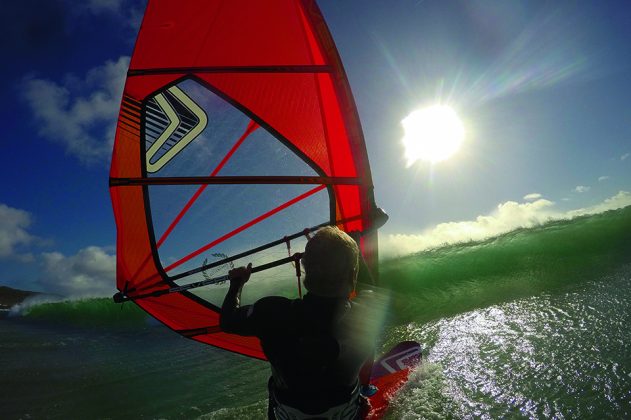“ PETER HART – HOLEY CHEESES ”
Words Peter Hart // Photos Hart Photography, John Michelin & Al Bennett
Originally published within the November/December ’17 edition.
More and more people are getting the tools and skills to challenge open waters. In a piece designed to inform rather than frighten, Peter Hart asks you to consider the ‘what happens if …’ factors.
One of the great mysteries in the realm of maritime disasters is the sinking of the Marie Rose, King Henry VIII’s flagship that inexplicably capsized and sank in the Solent just off Portsmouth harbour in 1545. The theories are many and varied. It was overcrowded with soldiers. Bystanders talked of a sudden gust of wind. It keeled over suddenly and with the gun ports open ready for battle, in rushed the water. She had recently undergone a refit. Extra guns had been added and perhaps she was simply too heavy – although she had just traversed the English Channel from London without a mishap. But in all probability it was an accident that conformed perfectly to the Swiss cheese theory of accidents. You take 5 slices of a holey Swiss cheese and lay them on top of each other. If you keep rearranging them, eventually the holes will line up. That’s when your accident occurs. It’s the unfortunate coming together of a series of minor events. Only one slice has to be out of line for the disaster to be averted. So for your information, this is what happened to the Marie Rose.
It was a NW wind. Having blown over the Downs, NW winds are unstable and gusty. They often occur after a depression has passed up the Channel from the Bay of Biscay and follow strong southwest winds, so there was probably a residual swell.The ship was a bit heavy and over-crowded and the gun ports were open ready for battle. The admiral had admitted he had ‘the sort of men that he could not rule.’ We imagine the crew to be uniquely stout English archers and soldiers. But actually most crews were made up of international mercenaries, Spanish, Portuguese etc. There were certainly communication issues.S o the captain made a hard turn to the north just as he was hit by a strong, gust and by a rogue swell. He yelled to his crew to move to starboard to trim the ship, but most didn’t understand and ran the wrong way, thereby tipping the ship over. Momentarily all the holes line up. You heard it here first folks.
THE SURVIVAL OF THE LONE SURFER
Being watery types, you may have followed this year the incredible story of surfer Matthew Bryce who was blown offshore from the beach of Machrihanish on Scotland’s Argyl coast, survived 32 hours at sea clinging to his board before being rescued by helicopter 12 miles off Northern Ireland. In terms of common sense and safety, he’d broken just about every rule in the book. He was alone. No one was looking out for him or expecting him back at a certain time. The wind was strong and offshore and Machrihanish is famous for its fierce rips. But this time, the holes didn’t quite line up. He wasn’t injured; he was obviously very fit and resilient; he’d hung onto to his craft; and perhaps most crucially, despite it being the mild month of May, he was wearing boots, gloves and a hat. He was already in a state of advanced hyperthermia when rescued and the extra heat loss from bare extremities would surely have tipped him over the edge.
“ I would love to say that all windsurfers are naturally sensible and err on the side of caution.
But some are just lucky and have been riding their luck for years. ”
BOTTOMLESS SUBJECT
The topic of windsurfing safety, when delivered via a 5 hour Power Point presentation listing every possible mishap along with a list of ‘don’ts’ and ‘must nevers,’ can be cripplingly demotivating as well as an instant cure for insomnia. The best lessons are gleaned through experience … but preferably someone else’s. Stories are so much more real and relevant than rules. Hence I’ve asked friends and clients to share their ‘moments’ and interestingly, everyone has had them – and embraced them. The experience has alerted them to hitherto unseen dangers – and we absolutely need danger to be safe. Maybe that’s a good place to start.
Dangerously safe
Talk of windsurfers in mortal danger and you think of foolhardy adrenalin junkies dropping down monster barrelling waves breaking thunderously over outer reefs. Most of them have had chilling moments but the fact that none (that I know of at least) have perished reveals that these guys and girls are fastidiously prepared. They are supremely fit with the right kit. Wind and swell charts have been pawed over for weeks to isolate the exact time frame for the onslaught. They have helmet, impact vest and probably a jet ski in the channel with a highly skilled rider ready to sweep up the pieces. By contrast one of the worst accidents I witnessed was to my friend Matt who went sailing in the flatter than flat Dahab lagoon at 8.30 am in a force 4 just after the centre opened. 20 minutes later he was in the rescue boat with a punctured lung. There were just two of them out on that vast expanse of sheltered water and they collided. It appeared so safe that neither was looking. It’s the driving in Rome vs driving in the sleepy countryside analogy. In Rome where cars are flying at you at huge speeds from every angle, horns blaring, you are acutely aware of the potential dangers and therefore hyper alert and ever ready to take evasive action. In the countryside where at a steady 30 mph along a deserted lane, you’re taking in the view with your head in the clouds, it’s the totally unexpected stationary tractor around the next bend that ruins your day.
Every windsurfing incident I’ve been told about has be en a tale of the unexpected. Being aware of your vulnerability is a positive thing.An expert on road safety suggested the best security measure would be a knife pointing out from the steering wheel at the driver’s chest as a way to highlight the consequences of a collision.The most dangerous state of mind is that where you believe you’re 100% safe.But all will be OK, you say, because whatever happens, there’s always the rescue services. Discuss.
“ So as windsurfers when are we most at risk? When we least expect it. ”
RESCUE SERVICES
Rescue comes from various quarters – some noble, others less so. Self-rescuing is a fine, venerable art. If you stow your kit and paddle in, manage to cobble together a jury rig and stagger home; sail back without a fin etc., you arrive on shore perhaps knackered but empowered by a feeling of confidence and independence.
If you get rescued by another windsurfer or windsurfers, who either carry bits of your rig in for you so you can paddle home, or tow you in; or in a more serious scenario, stay with you, support you and float in with you because you’re injured, the experience reinforces the importance of sailing with a group and strengthens the bonds.
Getting pulled in by the rescue craft of a centre? Well it’s what they’re there for. In Vassiliki for example, the armada of RIBS allows improvers to experiment with impunity. They can bear off endlessly in the knowledge that a lift back upwind is never far away, saving time and energy. It’s all part of improving, so long as the student doesn’t carry a false sense of security when he or she moves to unpatrolled waters. But as for the emergency services, to be a victim can be harrowing, embarrassing, expensive, and traumatic as well as bringing unwelcome publicity.
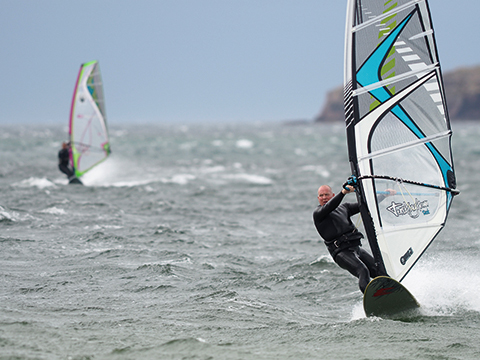
The ‘death defying’ Bill Oliver, something of an involuntary media star back in the 80s thanks to his rip in the Aberdeen lifeboat.
PHOTO Hart Photography
Bill Oliver takes up his story.
“It was winter on the Aberdeen coast. The wind was 30 knots SW side off and I was on a UFO board with a 4.5 sail. This was 1983 so the kit wasn’t great. Suddenly the wind veered westerly (more offshore), increased and I couldn’t waterstart. I was taken north by the swell and couldn’t swim against the wind, so I hung onto the salmon nets, de-rigged and waited for the wind to drop. But I’d been spotted and the Aberdeen lifeboat came out and picked me up. The lesson? I was guilty of ‘just one more run …’ syndrome and had stayed out too long. It wouldn’t happen today because I’m better, the kit is better and would have allowed me to sail home. I’d also have got a more detailed forecast. But the worst thing was that when I got in, the ambulance was waiting along with a bunch of journos. The next day I was all over the Scottish Dailies: ‘Death defying windsurfer cheats death!’ The lying scumbags!”
To have been picked up by the emergency services is to have won … and lost. They should be seen as a welcome but distant last-chance-saloon safety net, a reminder that you forgot to take your preventive medicine – not as a divine right. Shake your head disapprovingly at the following.
One afternoon in Mauritius the red flag was flying meaning the swell was of a size and direction that the channel was closing out and it would be dangerous/impossible to get a rescue boat to anyone who broke down on the far side of the reef. A frantic bloke runs to Club Ion (formerly Mistral) saying his friend was in trouble with broken kit on the other side of the One Eye Reef. Despite the massive danger, Matrix, the best boat driver, dodged the bombs through the channel, got to the stricken sailor and dragged him in. Stern warnings were offered. Half an hour later the same guy was in trouble in the same spot. He’d re-rigged and gone straight back out. Later when asked what the ffff his game was, he simply replied “It’s your job to rescue me …” It was an extraordinary attitude which surely one day will result in natural selection.
“ Personally I feel far more vulnerable offshore in open water than I do in breaking waves. Waves break (mostly) in shallow water close to shore and offer a free ride home, whether you’re attached to your kit or not.”
BACK TO HOLEY CHEESES
The ways a good day turns into a dangerous one are when:
You run out of skill – you launch into conditions you can’t handle or select a board and rig combo that’s too challenging.
You run out of kit – something breaks.
You run out of coping strategies – no plan of how to self-rescue – never practiced.
You run out of strength – unfit, no stamina. Fatigue prevents waterstarting, uphauling, balancing and leads to bad, panicky decisions.
You run out of weather (or get too much) – an unforeseen change in wind and sea state changes the whole scenario.
You run out of company – you’re out there alone.
You run out of shoreline – you’re too far out.
You run out of health – you get injured.
One of the above happening may not be too bad. But when one or two or three coincide and the holes start to line up, that’s when dark clouds gather. Certain combinations quickly produce a perfect storm.
Unfit bloke sailing way offshore. Bad. Unfit bloke sailing offshore crashes and breaks UJ. Worse. Unfit bloke sailing alone offshore, crashes and breaks UJ. Very serious. And if the unfit, alone bloke is injured and the board separates from the rig and floats off downwind – he’s potentially another Marie Rose.
Sailing alone heads the ‘no no’ list. But close behind them and the ones you have the most control over are sailing way offshore and the fitness question.
INCAPACITATED
If you’re fit, unharmed and appropriately dressed, as Matthew Bryce displayed, you can find a way out of the most extreme situations. It’s when you get injured that suddenly the game changes…
Jim McNaughten
“I was in Jeri in Brazil. It was getting late. Conditions were perfect 5.0 weather so I decided on one last blast out to sea. I gybed on a swell, blew it and when I surfaced knew something was wrong. I’d dislocated my shoulder. It was so painful there was no way I could waterstart. In fact all I could do was lie in the water because that was the only comfortable position. I didn’t realize how far out I was – way beyond all the other sailors. Luckily an instructor had seen me. He told me not to move and stay with the kit and he’d get the boat. Because we were so far downwind by this stage, it took ages for him to get back. And by the time the rescue boat came it was getting murky and they took a while to find me – bloody scary. Heavens knows why, irrational panic I guess, but I was even contemplating abandoning the kit and swimming for it. I’m a good swimmer but no one can swim with a dislocated shoulder. I guess you don’t realize when you’re fully planing in a sideshore wind, how much ground you cover. The lesson I got was never to be the furthest one out.”
I’ve encountered a few injuries out to sea. With lower limb injuries, I’ve recovered the victim’s rig and got them in the waterstart position from where they can drag in. But the worst have been dislocated shoulders because the victims can do virtually nothing. They’re pretty rare. I’ve only encountered 2 and the way we got one in was four of us to cradle him in his rig. Luckily he wasn’t alone and not too far offshore. It’s at those rare moments when buoyancy is a lifesaver…
“ The wind doesn’t necessarily get stronger the further you sail out. And if you get injured, the closer you are to shore,
the happier you’ll feel.”
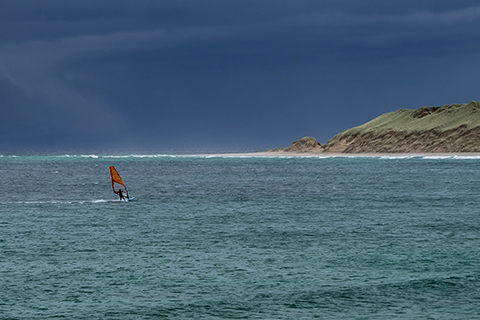
THE FICKLE ELEMENTS
Thanks to detailed forecasts these days there’s less of an excuse for being caught out by changing weather. But over-reliance on the weathermen is equally perilous. They don’t always get it exactly right. Some locations, often those where ocean and mountains meet, are famous for their own weather events. Don’t forget to lift your head and read the signs. When rain clouds approach you know can expect the wind to build and drop suddenly and change direction.
Horizon Hunters
It’s the horizon hunters who frighten me most. In a slightly schoolmastery way, I sail up to them, get them to drop their rigs and ask (staring downwind at a blank horizon or a set of cliffs): “If you have a problem here, what exactly is your exit strategy?”
Doug McCleish
“I was sailing from Little Haven to Newgale in Pembrokeshire, planing along beautifully when the wind dropped. The two beaches are separated by cliffs. People on the cliffs saw me wallowing and called the lifeboat. I was too proud to accept a lift and just made it back. I learned a vital lesson there which is not to sail somewhere you can’t get out of.”
The general rule is to be no further offshore than you can swim.
Are you a strong swimmer and do you have the gear to help or hinder?
Swimming Issues
I arrived at Kilcummin beach in Kerry desperate to get out there on a beautiful logo to mast high day only to realize … I’d left my wetsuit on the line. “No worries,” said Brummie Dave, “you can borrow my spare one.” It was a bit snug and made of that material ‘Hyperlon’ that some brands used, which had pretty colours but as much stretch as old cardboard.
After a couple of waves I got taken down on the outside and found out the suit was so solid that I physically couldn’t swim. For a good 20 minutes I was washed in by the surf and then sucked out again by the undercurrent, bobbing around like all the other jetsam, until eventually a big set washed me into my depth.
Have you tried swimming any distance in your wetsuit, harness and whatever other devices you like to wear?
In waves you often have to do a bit of sprint crawl to get to your kit before the next dumper washes it away. But if you’re in relatively calm open water, then the board is surely going to be right there for you as you surface after a fall? Most of the time yes. But ….
Jane Williams
“ I was gybing … which often doesn’t turn out well. As the board accelerated I literally just fell off the back (I know …lean more forward!) but this one time as I let go of the rig, the boom balanced on the tail and the board just kept going without me. I’m not a great swimmer and there was no way I could catch up with it. Luckily a guy saw it, grabbed it and waited for me to doggy paddle my way to it and get reunited. I was fine but it could have been nasty if I was alone. By the way, I was wearing a bulky buoyancy aid. It helped me float but certainly didn’t help me swim.”
I’ve seen this happen a few times and the top rule is in all but a few extreme wipeouts, keep a hold of the boom. On a stormy wet Friday night in January I was driving home in my relatively new Ford Sierra Estate from Anglesey circa 1990. The heater was on, the music was inspiring and all was dandy in my cosy cocoon. Then followed a splutter and a bang and the fire went out. I was on the mountainous A5 in North Wales miles from anywhere. I got out and was struck by the sudden hostility of the environment – cold, wet, dark miserable. I opened the bonnet but this wasn’t my old Morris Traveller, where all you had to do was bang the fuel pump with a spanner and she’d spark back into life. I had no idea what I was looking at. This was before mobile phones. I was freezing, helpless and totally at the mercy of others. Such is the plight of windsurfers who break down without an exit strategy. It’s shocking how different the world looks from blasting along happily hooked in, to viewing a crumpled rig from sea level 2 miles from shore and realizing you have no Plan B.
THE FATAL LURE of the HORIZON
It’s when the swell drops on a wave clinic and everyone goes for a ‘yahoo’ freeride blast, that I worry the most. Most only have to be planing out to sea for 30 seconds to be further out than they can comfortably swim back. The problem is that the outer sea state, beautiful rolling swells, can be ever so alluring. So make sure you’re in good company and have a friendly lee shore. But that same outer sea state can also bring a challenging dimension to the fragile waterstarter – waves that grab at clew and cloth and hide the wind. There are few activities more draining than recovering a rig in heavy swells.
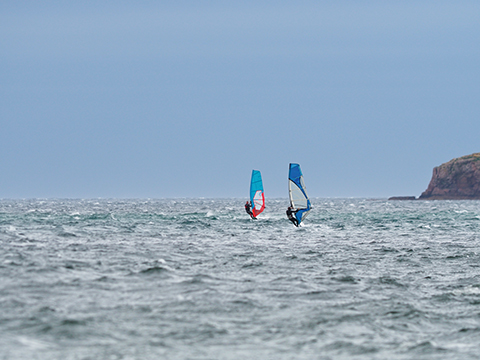
A couple of the Masterclassees hooning off to Newfoundland last month. They were being monitored but self-rescuing from that far out is a right mission. PHOTO Hart Photography
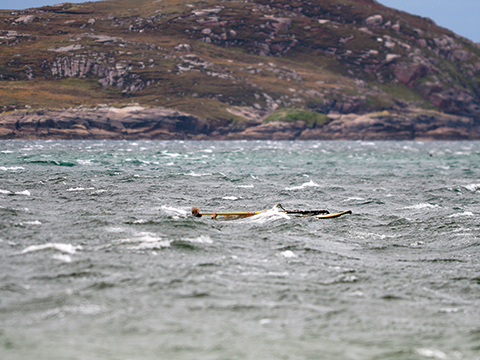
Waterstaring way offshore in confused seas can be tricky and tiring – and you’re hard to spot. PHOTO Hart Photography
BUOYANCY
Where do you stand on this? Most advanced windsurfers don’t wear extra buoyancy. Some say it’s a liability in the waves when you need to sink the rig and duck under the white water. Some say it hinders swimming. But in most cases it’s because it’s not part of the culture – buoyancy aids don’t look cool. However, that’s changing. Big wave riders all wear them. They can get held down for so long that they need all the help they can get scratching up through the aerated foam. And if they get knocked out, they’ll bob to the surface and be spotted by the jet ski.The latest ones are slim fitting and double up as impact vests. They look pretty cool and you can swim in them. Manufacturers advise that they ‘aid buoyancy’ rather than being a full anti-drowning advice, but that may be all you need. And what about helmets?
Ron
I’ve been asked to conceal his full name because he’s not sure he’s told his wife about this incident.
“I was sailing the waves in Tiree. I was riding a big wave and got overtaken and tumbled by the white water. I felt a bang against my head. But when I surfaced my kit was nowhere to be seen. It wasn’t my own kit that had hit me but my mate who hadn’t seen me, had run over me – and it was his fin touching my head!”
Ron now wears a helmet.
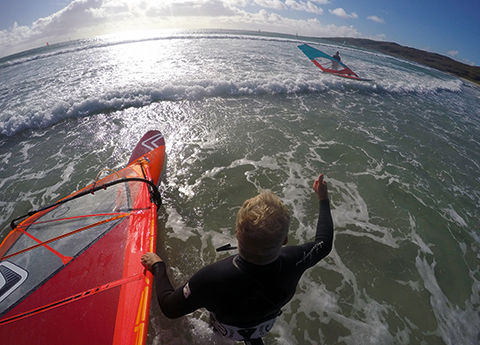
Clocking a mate on the way out. Any company is better than none but sailing with people who know you’re out there (and vice versa) is the way to go. PHOTO Hart Photography
THE MATE FACTOR
Not sailing alone is about the best thing you can do to protect yourself. Windsurfers are famously good at looking out for each other … in most places. I was in a very popular European spot, bust a mast on the outside, was obviously in trouble but I reckon 50 people sailed past before one stopped to see if I was OK. Like cities, some spots are full of people but can be quite lonely. There’s a big difference between sailing where there are others and sailing with a group who have clocked you and are
genuinely aware of your presence out there.
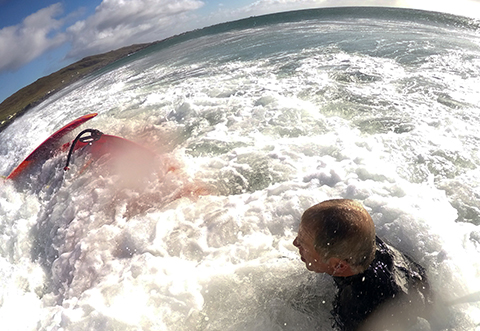
Stay calm and go with the flow. PHOTO Hart Photography
STAYING CALM
The RNLI have posted some excellent videos recently about how to avoid drowning – top of the list of which is staying calm to preserve energy. The first time you’re taken down in breaking surf can be worrying as you battle currents and claw frantically and impotently at the foam. I was in Tiree recently on a beautiful day, head to logo high waves but nothing too serious. I got trounced in the impact zone and for a while there was little wind and no gap between the sets. I noticed I was in a loop, waves washing me, undertow pulling me out again. Suddenly I realised that it was exactly this situation where inexperienced sea goers and swimmers panic and sometimes perish. So as a sort of experiment I did nothing – just hung onto my mast tip and went with the flow. After about 5 minutes a bigger set washed me further in where I could stand up and beachstart away. By keeping a low heart rate, your decision-making is vastly improved. The only problem was that everyone on the beach thought I’d lost the plot.
BUSTED KIT
There are so many potential kit failures and recovery methods that it’s a subject for another time. However, the general situation can be summed up with the following tale. It was winter from another millennium and one of those rare south coast days where after a westerly gale, the cold front passes and the wind swings NW and we get a few hours of classic side off conditions. That NW wind typically switches off pretty suddenly (which I didn’t realize then … another story) which it did when I was well beyond the break. I’d never self rescued a wave board before but decided to give it a go and started de-rigging. The results were Chaplin-esque as nothing would stay rolled up or on the board – and there were all these options I’d never considered – mastfoot in or out? Harness on or off? Battens in or out? Sail de-sleeved or rolled around the mast? Finally I started to make a little headway when the wind suddenly got up again. Have you ever tried to re-rig out at sea? I hadn’t. It was tricky .. and ultimately impossible because the mast extension had dropped in and sunk.
The two rules about stowing a rig and paddling home are:
• You’ll lose anything that isn’t tied on.
• Practise it on dry land and then on the water.
I can’t leave this subject without a quick mention of mastfeet.
In 2016 there were 82 launches by RNLI lifeboats to help windsurfers.
In 1983 the Hayling lifeboat alone was called 70 times (so it appears as a race we’re getting more competent) and 70% of those were due to mastfoot issues.
Mastfeet are so much better these days but they still fail.
Check the UJ for cracks and make sure it’s done up tight. Last week in Donegal one of my gang had trouble when the whole assembly slid out. As he’d tightened it, sand had got trapped between the disc and the board. When the sand washed away, the mastfoot loosened up.
FINN MULLEN – it’s all in the preparation
Our esteemed editor Finn Mullen over the years has put himself into monster surf situations, with and without a rig, way way way beyond the remit of most humans. He’s still here to tell the tale so talks much sense on the subject of staying safe.
“Preparation for big days for me involves many factors. A big part is the kit – is it seaworthy? Do you trust its performance and know its limits. Modern equipment’s range and reliability has improved vastly. It is ok of course to have older gear but expecting it to be reliable and safe on those bigger days is a gamble that I have seen not work out unfortunately for other sailors, including one of the nastiest incidents that I have witnessed and involved a helicopter rescue of absolutely heroic airmanship by the coastguard crew involved. Equipment failure can happen to anyone but I do strongly feel that by using up to date gear does reduce the risk to both yourself and the rescue services. But any day on the water can turn sour – we can drown in a few inches of water or XXL waves, so that healthy respect for the water is always in my mind. I make sure I have studied the forecasts in detail so I know the safest window of time to sail. Bigger days I reduce the risk by using buoyancy aids, (I wear 2 or 3 on really big days), lights, whistles, swim fins attached to my harness, spare lines for self rescue or towing others, a waterproof phone and lots of insulation (a good wetsuit with layers also) and a spotter and / or jet ski rescue crew where possible. It depends on the day, how much of that I employ, assessing the worst-case scenarios. I have practiced with all the extra safety gear on flat water so I know how it feels to have all that extra bulk when sailing which helps another important factor – your confidence. Much of surviving in water-based incidents is remaining calm, as the RNLI’s latest campaign advocates. If you are too nervous that’s a sign to not go out and I have walked away from more big days than I have actually sailed in.
Big wave SUP surfing has been a recent positive addition to my technique base in that you don’t have the same ‘engine’ to power you out of trouble as a windsurfer. You generally get wiped out more and with a large board attached to your leg the beatings are ‘interesting’ to say the least. That exposure all helps with confidence in the water that crosses over into your windsurfing. I will generally opt for a board and sail slightly up in size so I know that I have some reserve volume and power to get me back to shore if it’s time to look for an exit.
Being familiar with the spot you are sailing also helps reduce the variables and increase confidence. Any time spent at a break – surfing, SUP’ing, windsurfing or even swimming in it all helps to your knowledge base of its nuances. Of note is my worst experience was on a 4.5 day jumping swells far from shore with friends nearly 30 years ago. In mid-air my mastfoot separated from the board, a common complaint back in the day! My board sailed off quickly downwind in the swell on its own, while I was left with my rig. Quickly I realised that my rig was the best form of signal to my fellow sailors so started to hold and flip it above my head and soon attracted my friend (thank you Ian Coulter!) who went in to get my dad to save the day! Had I been in a surf zone I would have washed in easily, but being far out the back jumping swell lines it was a different story and reminded me that danger can come at any time and a lot of rescues happen to windsurfers when they get into trouble on flat days far from shore. So the moral is, respect the water no matter what the wind or sea state. It is an environment that we can enjoy but ultimately are not built to survive in. Check your kit, the conditions and yourself and always know there is no shame in walking away if you don’t feel happy about any of these.”
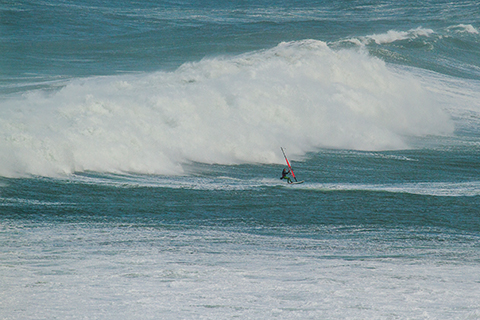
Finn, equipped with multiple buoyancy aids, swim fins, phone etc along with skill, fitness and a lifetime of big wave experience, is as safe as it’s possible to be on a monstrous day in Donegal. PHOTO Al Bennett
And to summarise …
No mistake is too dumb to make.
You don’t have to approach every session like a compulsive, obsessive, nervous Nellie but a quick checklist can save a lot of bother.
You rig and so doing check for cracks in the mast and UJ and for frayed ropes … no it won’t do for just one more session.
You’re sailing with mates. You’ve made a pact to look out for each other.
You’ve checked the forecast and are aware of any sudden predicted changes in wind strength and direction.
You’re aware of the tide, the direction of flow and when it will change.
You’ve set yourself an outer sailing limit and have worked out where you will end up if you break down.
But you know what … if you just sail with mates and stay close to shore, you should be fine!
Harty looks at style in the next issue. Do you have one? Do you want one? Do you want to change it? And check out www.peter-hart.com for his 2018 clinic schedule.


